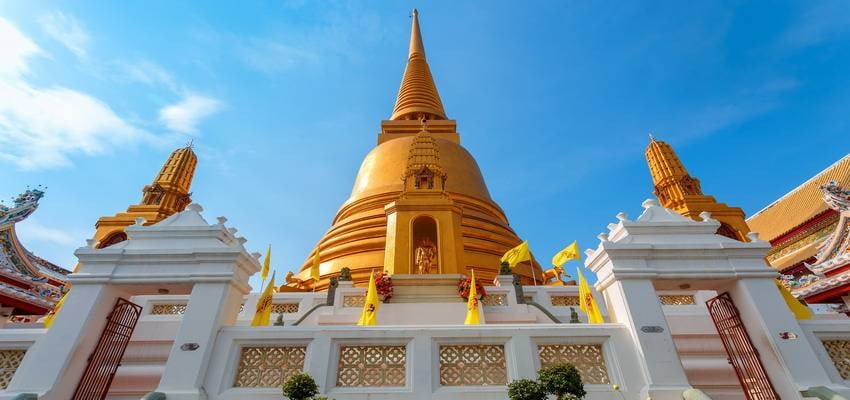Table of Contents
Nestled amidst the bustling streets of Bangkok lies a serene oasis, a place of solace and reflection – Wat Bowonniwet.
This temple, located in the Phra Nakhon district of the city, is a haven for locals and tourists alike seeking to escape the chaos of the city and immerse themselves in Thai culture and tradition.
It is a temple of great importance to Thai Buddhism and is home to one of the most revered monks in the country, Somdet Phra Phutthachan (To Phromrachamat).
The temple was built in 1829 by King Rama III as a royal monastery for his half-brother, Prince Maha Sakdiphonlasep. King Rama IV later expanded the temple complex, making it his main residence before ascending to the throne.
This beautiful temple is a hidden gem that many visitors to Bangkok often overlook. In this blog, we will take you on a journey through the history, architecture, and significance of Wat Bowonniwet.
History of Wat Bowonniwet
The temple was founded in 1829 during the reign of King Rama III of the Chakri dynasty. The temple was built as a royal residence for Prince Maha Sakdi Polsep, the king’s younger brother, who later became a senior monk and the abbot of the temple.
In 1836, King Rama III decided to convert the temple into a royal monastery, and the temple was renamed Wat Bowonniwet Vihara.
The temple became a center for Buddhist learning and practice, and many members of the royal family, including Prince Maha Sakdi Polsep, resided there.
Over the years, the temple has been home to many famous Thai monks, including King Rama VI, who spent several years as a monk at the temple.
During the reign of King Rama V, the temple was renovated and expanded, with the addition of several new buildings and structures, including a new ordination hall, a library, and a pagoda.
The king also commissioned the creation of several important Buddha images, including the Phra Buddha Chinnarat image, which is now housed in the temple’s ubosot, or main hall.
In 1903, King Rama V’s son, Prince Mahidol Adulyadej, was ordained as a monk at Wat Bowonniwet. Prince Mahidol was a medical doctor and a scholar, and he used his time at the temple to study Buddhism and to further his knowledge of medicine.
He later became an important figure in the Thai royal family and is widely regarded as the father of modern medicine in Thailand.
The architecture of Wat Bowonniwet
The temple’s architecture reflects a blend of traditional Thai and modern styles, with a unique character that makes it stand out.
The temple complex is composed of several buildings and structures, including the main chapel, the ordination hall, a bell tower, a library, and monks’ living quarters.
The buildings are designed in style with steeply pitched roofs, intricate gables, and detailed carvings. The use of gold leaf and bright colors further adds to the visual appeal of the structures.
The most notable building in the temple complex is the Phra Ubosot, or ordination hall, which is a beautiful structure with a three-tiered roof decorated with gold and green tiles and topped with a shining golden spire.
The interior of the hall is equally impressive, with murals and paintings that depict scenes from the life of Buddha and Thai mythology.
Another noteworthy building is the Phra Atthama Chedi, which is a large stupa or pagoda that stands in the center of the temple complex. The stupa is covered in gold leaf and features intricate carvings of Buddhist deities and mythical creatures.
Significance of Wat Bowonniwet
Wat Bowonniwet is an important religious and cultural landmark in Thailand, and many visitors come to the temple to pay their respects and seek spiritual guidance. The temple is home to several important relics, including a statue of the Buddha and a sacred Buddha footprint.
The temple is also significant because it serves as the spiritual center for the Thammayut Nikaya, a Buddhist monastic order founded in the 19th century.
Many of Thailand’s most revered monks have studied and trained at Wat Bowonniwet, making it a vital institution in its religious and cultural heritage.
Visiting Wat Bowonniwet
If you’re looking for a peaceful and tranquil escape from the hustle and bustle of Bangkok, Wat Bowonniwet is the perfect destination. The temple is open to visitors every day from 9 am to 5 pm, and admission is free.
When you visit the temple, be sure to dress appropriately and show respect for the sacred space. Hiring a local guide who can provide insights into the temple’s history and significance is also a good idea.
Final Words
Wat Bowonniwet is a beautiful and unique temple that offers visitors a glimpse into Thailand’s rich cultural and spiritual heritage.
Whether you’re seeking spiritual guidance or simply want to appreciate the temple’s stunning architecture, Wat Bowonniwet is a must-visit destination in Bangkok.
So, the next time you’re in the city, take a break from the chaos and visit this haven of peace and tranquility.
You can also check out some other stunning temples in Bangkok for a more diverse experience.



